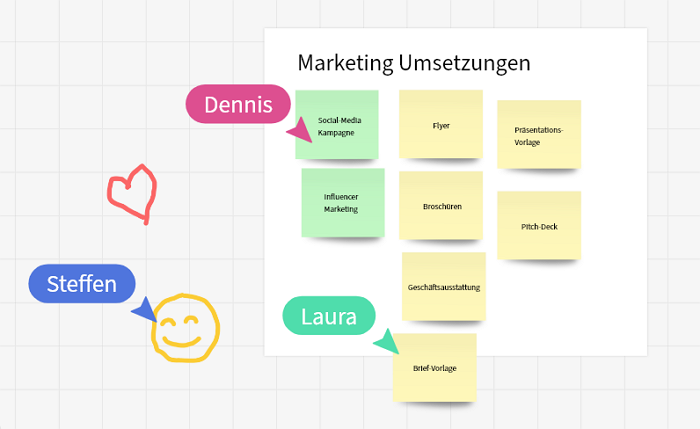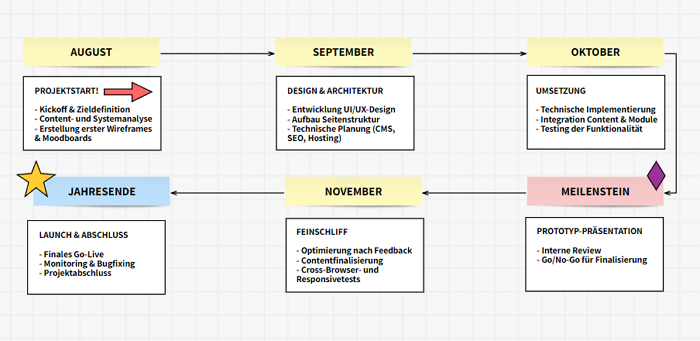Digital collaboration requires tools that go beyond traditional task lists. Especially when teams are generating ideas, planning processes, or reflecting together, they need a workspace that is both flexible and structured. In many cases, a chat thread or spreadsheet isn't enough to capture complex thoughts in a clear, visual way.
Whiteboards fill that gap. They make it easy to structure information freely, visualize ideas, and highlight connections. In Stackfield, whiteboards are seamlessly integrated into the digital workspace, combining creative thinking with practical execution. This makes them a powerful tool for a wide range of use cases – from ideation to retrospectives.
In this article, we explore the three proven techniques brainstorming, roadmapping and retrospectives and show how they can be implemented using Stackfield’s Whiteboard module.
How does the Stackfield Whiteboard bring structure to creative work?
The Whiteboard module in Stackfield adds an open, visual layer to the existing functionality. On the Whiteboard, users can place elements like text fields, shapes, lines, sticky notes, or images freely and creatively. This makes it suitable not just for simple sketches but also for structured processes and collaborative analysis.
Custom templates offer added flexibility, especially for recurring tasks. Whether it's a brainstorming board, a roadmap layout, or a retrospective structure: new whiteboards can be created in just a few clicks and tailored to individual needs.
Brainstorming in teams?
What Is Brainstorming?
Brainstorming is a creative technique used to quickly generate a large number of new ideas. The goal is to collect associations, thoughts, or potential solutions around a topic – without judgment or limitations. It's about encouraging free thinking and capturing spontaneous impulses as they arise.
Why Is Brainstorming Valuable in Daily Work?
In project teams, brainstorming fosters openness to new ideas. It helps make different perspectives visible that might otherwise go unnoticed, and allows diverse impulses to be developed and refined. With a visual aid like a whiteboard, ideas can be grouped, prioritized, and elaborated with greater clarity.

An example for brainstorming in Stackfield
How Does Brainstorming Work in Stackfield?
The whiteboard in Stackfield allows for the easy placement and grouping of color-coded sticky notes to capture spontaneous ideas – whether during meetings or at any other moment of inspiration.
Topics and clusters can be visually emphasized using shapes or lines. Unlike traditional analog whiteboards, Stackfield makes it possible to store all ideas digitally. This ensures that all project members have access to the shared idea pool at any time and can revisit or build on it collaboratively.
Planning roadmaps
What Is a Roadmap?
A roadmap is a visual planning tool that outlines key milestones or phases in a project or product cycle. Unlike a Gantt chart, a roadmap does not rely on rigid timelines or dependencies. Instead, it provides a high-level overview that leaves room for iteration and change while still offering a clear direction.
Why Are Roadmaps Useful in Day-to-Day Work?
Roadmaps offer one key advantage: transparency. They allow everyone involved to see what should happen and when, in what general order. This overview supports better alignment, more effective communication, and stronger deadline management. Teams can track progress more easily and respond early to delays or shifts in scope.

An example for a roadmap in Stackfield
How Does a Roadmap Look in Stackfield?
A roadmap whiteboard in Stackfield can be created using timelines, arrows, columns, and cards. Importantly, roadmaps don’t have to be linear. They can take many shapes such as serpentine flows, branching structures, or even circular designs for recurring processes.
Colored markers and shapes help highlight milestones, statuses, or responsibilities. Custom templates allow teams to build and reuse roadmap boards for products, projects, or sprints, which are flexibly adapted to current needs.
Creating retrospectives
What Is a Retrospective?
A retrospective is a structured team reflection session, usually held at the end of a sprint or project phase. It focuses on continuous improvement. Retrospectives provide space for feedback, recognition, and constructive criticism, encouraging a shared commitment to progress.
Why Are Retrospectives Important for Teams?
Retrospectives support a healthy team culture. When held regularly, they boost productivity and promote open communication. They also empower teams to self-organize and take responsibility for their workflows. The insights gained often lead to meaningful process adjustments and strengthen alignment around shared goals.

An example for a retrospective in Stackfield
How Does a Retrospective Work in Stackfield?
Stackfield’s whiteboard makes it easy to run structured retrospectives using established formats such as "Keep - Drop - Start" or "Mad - Sad - Glad." Team members contribute sticky notes or text cards in the relevant columns, helping identify which approaches to keep, which to avoid, and which to introduce.
Key takeaways can be directly converted into tasks or linked to existing projects. The visual format supports a constructive and creative atmosphere for open discussion and shared learning.
Conclusion: Greater clarity and structure through visual collaboration
Stackfield’s Whiteboards are more than just digital sketching tools. They combine creative freedom with deep functionality, helping teams work in a structured, transparent, and goal-oriented way. The Whiteboard module creates a shared space where collaboration becomes visible and trackable. For anyone looking to bring visual workflows directly into their daily routines, the Stackfield Whiteboard offers a versatile solution that bridges creativity and structure.
Almost finished...Please click the link in the email and confirm your email adress to complete the subscription process.
Never miss a post. Get awesome insights in your inbox.